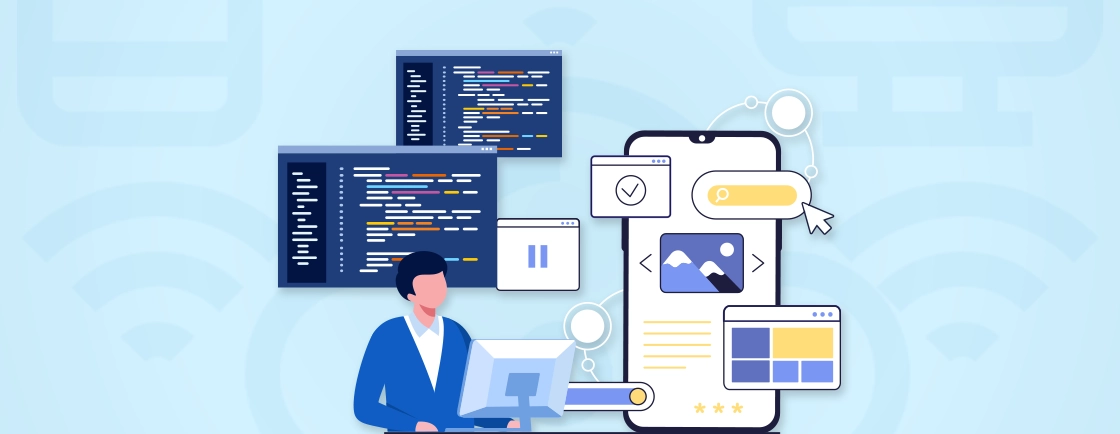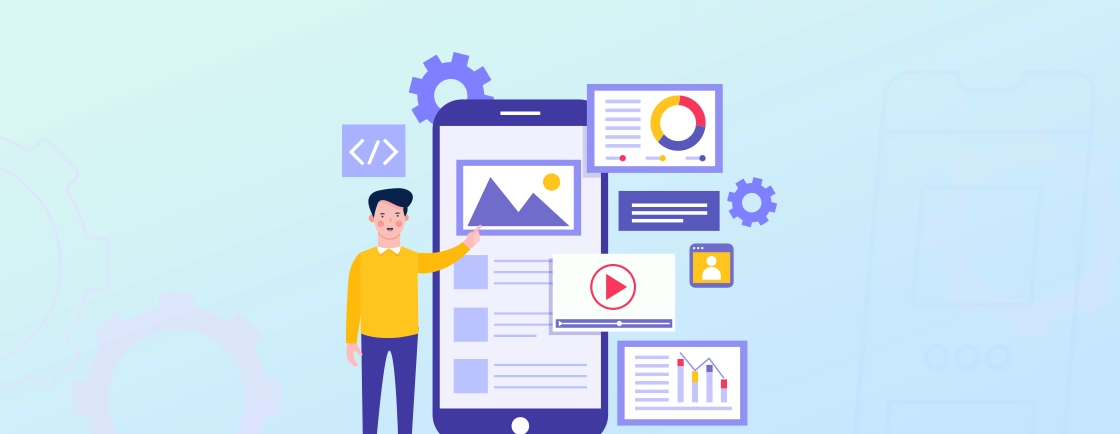Table of Contents
Over 6.6 billion people worldwide use smartphones, and mobile apps are at the heart of their digital experiences. For businesses and individuals trying to create the best mobile apps, choosing the right platform is critical to ensuring a seamless, scalable, and user-friendly experience.
With a myriad of options available, from native to cross-platform solutions, the decision between the top mobile app development platforms can be overwhelming.
So through this blog, we’ll discuss the top mobile app platforms and how the mobile app experts choose the suitable one for every project. Let’s begin.
What is a Mobile App Development Platform?
A mobile app development platform provides the tools and environment necessary to create mobile applications. Essentially, it’s a software suite that streamlines the app development process.
These platforms facilitate the design, coding, testing, and deployment of mobile apps. They often include integrated development environments (IDEs), software development kits (SDKs), and libraries of pre-written code.
Key Features
- UI design tools
- Access to device hardware (camera, GPS, etc.)
- Backend service integration
- Testing and debugging tools
- Deployment capabilities
Essentially, a mobile app development platform simplifies the complex process of creating mobile applications, offering a range of tools and resources to developers.
Types of Mobile App Development Platforms
When discussing mobile app development platforms, it’s essential to understand the core categories. Each category offers distinct advantages and disadvantages, influencing development speed, performance, and cost.
Native Platforms
Examples
- iOS: Swift, Objective-C, Xcode
- Android: Kotlin, Java, Android Studio
Native development is the most direct approach, tailoring applications to the specific operating system of a device. This ensures optimal performance and a seamless user experience.
Developers utilize the programming languages and tools provided by the operating system’s vendor. For Apple’s iOS, this involves Xcode and languages like Swift or Objective-C. For Google’s Android, Android Studio and languages like Kotlin or Java are employed.
Native apps have direct access to all device hardware and software features, resulting in highly responsive and feature-rich applications.
Pros
- Superior Performance: Optimized for the specific OS.
- Excellent User Experience: Adheres to platform UI/UX guidelines.
- Full Device Access: Leverages all hardware and software features.
- High Stability: direct OS integration.
Cons
- High Development Costs: Requires separate codebases.
- Longer Development Time: Building and maintaining separate apps.
- Maintenance Overhead: Separate updates for each platform.
Cross-Platform Platforms
Examples
- React Native (JavaScript)
- Flutter (Dart)
- Xamarin (.NET)
Cross-platform development aims to reduce development time and cost by enabling developers to write a single codebase that can be deployed on multiple operating systems.
Frameworks like React Native (using JavaScript) and Flutter (using Dart) are popular examples. These frameworks compile code into native components, offering near-native performance. The goal is to provide a balance between development efficiency and performance.
Pros
- Reduced Development Costs: Single codebase.
- Faster Development Time: Write once, deploy everywhere.
- Code Reusability: Significant code sharing.
- Large Communities: Strong community support.
Cons
- Performance Trade-offs: May not match native performance in all cases.
- Platform-Specific Limitations: Access to certain features may be limited.
- Debugging complexity: debugging can be more complex.
Hybrid Platforms
Examples
- Apache Cordova (HTML, CSS, JavaScript)
- Ionic (HTML, CSS, JavaScript)
- Capacitor (HTML, CSS, Javascript)
Hybrid development utilizes top web technologies like HTML, CSS, and JavaScript to build mobile applications. Frameworks like Apache Cordova and Ionic allow developers to wrap web applications in a native container, enabling them to run as mobile apps.
Essentially, the app is a web application displayed within a webview component of a native mobile application.
Pros
- Web Development Familiarity: Leverages existing web skills.
- Cross-Platform Compatibility: Deployable on multiple platforms.
- Rapid Prototyping: Quick development cycles.
Cons
- Performance Issues: Can be significantly slower than native.
- User Experience Limitations: May not provide a native feel.
- Limited Device Access: Relies on plugins, which can be inconsistent.
- Reliance on webviews: Can create performance bottlenecks.
Understanding these distinctions is crucial for selecting the appropriate platform for your mobile app development project.
Popular Mobile App Development Platforms
Whether you’re building for iOS, Android, or both, there are several platforms offering the tools and frameworks needed to bring your app ideas to life.
React Native
Developed by Facebook, React Native is a leading open-source framework for building cross-platform mobile apps using JavaScript and React. Its “learn once, write anywhere” philosophy allows developers to create apps for both iOS and Android with a single codebase.
With a strong focus on performance and a rich ecosystem of libraries, React Native is ideal for startups and enterprises aiming for faster development cycles without compromising on native-like experiences.
Key Features
- Cross platform mobile development with a single codebase.
- Uses JavaScript and React.
- Hot reload for real-time updates.
- Strong community support and third-party plugins.
Suitable for: iOS and Android
Flutter
Google’s Flutter is a UI toolkit for crafting natively compiled applications for mobile, web, and desktop from a single codebase. Powered by the Dart programming language, Flutter stands out for its customizable widgets and fast rendering engine.
Its hot reload feature accelerates development, making it a favorite for developers prioritizing expressive designs and high-performance apps.
Key Features
- Cross-platform development using Dart.
- Rich UI components and customizable widgets.
- High performance with native-like experience.
- Hot reload for faster development.
Suitable for: iOS and Android
Swift
Apple’s Swift is a powerful, intuitive programming language designed for iOS, macOS, and beyond. Known for its speed and safety, Swift simplifies app development with modern syntax and robust memory management.
It’s the go-to choice for developers building high-performance, native iOS apps, offering seamless integration with Apple’s ecosystem and frameworks like SwiftUI.
Key Features
- Native iOS development language.
- Modern syntax and easy to learn.
- High performance and safety features.
- Seamless integration with Apple ecosystems.
Suitable for: iOS
Objective-C
As the predecessor to Swift, Objective-C remains a reliable language for iOS and macOS development. While its syntax is more complex, it offers deep compatibility with Apple’s frameworks and legacy systems.
Objective-C is often used in maintaining older apps or projects requiring tight integration with C and C++ libraries.
Key Features
- Legacy language for iOS development.
- Robust and mature with extensive libraries.
- Compatible with C and C++ code.
- Still used for maintaining older iOS apps.
Suitable for: iOS
Kotlin
Endorsed by Google as the preferred language for Android development, Kotlin combines simplicity with powerful features like null safety and coroutines.
Its interoperability with Java makes it a versatile choice for modern Android apps, enabling developers to write concise, expressive code while leveraging existing Java libraries.
Key Features
- Modern language for Android development.
- Fully interoperable with Java.
- Concise syntax and reduced boilerplate code.
- Officially supported by Google for Android.
Suitable for: Android
Android Studio
The official IDE for Android development, Android Studio provides a comprehensive suite of tools for building, testing, and debugging apps. With features like a visual layout editor, APK analyzer, and built-in emulator, it streamlines the development process for creating high-quality Android applications.
Key Features
- Official IDE for Android development.
- Supports Java, Kotlin, and C++.
- Built-in emulator and debugging tools.
- Integration with Firebase and Google Cloud.
Suitable for: Android.
Xcode
Apple’s integrated development environment, Xcode, is essential for building apps for iOS, macOS, watchOS, and tvOS. It offers a powerful code editor, Interface Builder, and debugging tools, all integrated seamlessly with Swift and Objective-C. Xcode’s Simulator allows developers to test apps across various Apple devices effortlessly.
Key Features
- Official IDE for iOS development.
- Supports Swift and Objective-C.
- Interface Builder for designing UIs.
- Integrated testing and debugging tools.
Suitable for: iOS
Xamarin
Owned by Microsoft, Xamarin enables developers to build cross-platform apps using C# and .NET. Its ability to share code across platforms reduces development time, while still delivering native performance.
Xamarin.Forms, a UI toolkit, further simplifies the creation of consistent user interfaces across iOS and Android.
Key Features
- Cross-platform development using C#.
- Shared codebase for iOS, Android, and Windows.
- Native performance and access to native APIs.
- Integration with Visual Studio.
Suitable for: iOS and Android
Apache Cordova
Apache Cordova is an open-source framework for building hybrid mobile apps using HTML, CSS, and JavaScript. By wrapping web applications in a native container, Cordova allows developers to access device features like the camera and GPS.
It’s a cost-effective solution for businesses targeting multiple platforms with a single codebase.
Key Features
- Hybrid app development using HTML, CSS, and JavaScript.
- Access to native device features via plugins.
- Single codebase for multiple platforms.
- Ideal for simple apps and prototypes.
Suitable for: iOS and Android
Ionic
Ionic is a popular framework for building cross-platform mobile apps using web technologies like HTML, CSS, and JavaScript. With a rich library of UI components and seamless integration with Angular, React, and Vue, Ionic empowers developers to create visually appealing, performant apps.
Its focus on web standards makes it a flexible choice for hybrid app development.
Key Features
- Hybrid app development with web technologies (HTML, CSS, JavaScript).
- Extensive library of UI components.
- Integration with Angular, React, or Vue.
- Cross-platform with a single codebase.
Suitable for: iOS and Android
So, want to create the best mobile app with any of these platforms? Then hire our mobile app development company.
But which of these platforms will be suitable? How to choose the best one?
How to Choose the Best Mobile App Development Platform?
Well, first off, there is no “best” mobile app development platform, per say. You need to choose a platform suitable to your technical other requirements. Here are the key factors to consider.
- iOS, Android, or Both: Decide whether you need a native app for a single platform (iOS or Android) or a cross-platform solution for both.
- User Demographics: Consider the dominant platform among your target audience (e.g., iOS for high-income regions, Android for emerging markets).
- Budget: Native development (Swift, Kotlin) can be costlier and time-consuming compared to cross-platform tools (React Native, Flutter).
- Time-to-Market: Cross-platform frameworks allow faster development with a single codebase.
- App Performance and Complexity: Native platforms (Swift, Kotlin) are ideal for resource-intensive apps like gaming or AR/VR. Hybrid platforms (Ionic, Cordova) work well for less complex apps like informational or content-based apps.
- Team Skills: Choose a platform that aligns with your team’s expertise (e.g., JavaScript for React Native, Dart for Flutter, C# for Xamarin).
- Learning Curve: Consider the ease of onboarding new developers if needed.
- Customization: Native platforms offer superior UI/UX capabilities and access to platform-specific design guidelines.
- Consistency: Cross-platform tools like Flutter and React Native provide consistent UI across platforms but may lack platform-specific nuances.
- Ecosystem Compatibility: Native platforms often have better integration with their respective ecosystems (or app store) (e.g., Apple Pay, Google Maps).
- Long-term Maintenance: Cross-platform apps are easier to maintain with a single codebase, while native apps may require separate updates for iOS and Android.
- Scalability: Consider how well the platform supports future updates, feature additions, and scaling to more users.
- Data Sensitivity: Native platforms generally offer better security for apps handling sensitive data (e.g., banking, healthcare).
- Flexibility: Choose a platform that allows migration or integration with emerging technologies (e.g., AI, IoT).
- Compliance: Ensure the platform meets industry-specific compliance standards (e.g., GDPR, HIPAA).
- Official Support: Native mobile platforms (Swift, Kotlin) are backed by Apple and Google, ensuring long-term reliability.
| Platform Type | Best For | Examples |
|---|---|---|
| Cross-Platform | Apps targeting both iOS and Android with a single codebase. | Flutter, React Native |
| Native | High-performance, platform-specific apps. | Swift (iOS), Kotlin (Android) |
| Hybrid | Simple apps with basic functionality and faster development. | Ionic, Apache Cordova |
You can, of course, get help from our hire dedicated mobile app developers if you want the best platform for your mobile application.
Let’s Summarize
Choosing the right mobile app development platform is a critical decision that can shape the success of your app. Whether you prioritize performance, cost-efficiency, or time-to-market, each platform—from native options like Swift and Kotlin to cross-platform frameworks like Flutter and React Native—offers unique strengths to meet diverse needs.
By understanding the key features, suitability, and trade-offs of these platforms, you can align your choice with your project’s goals and target audience. The right platform is not just a tool; it’s the foundation of your app’s future.
So, want assistance with your mobile app development? Then consult with a mobile app development company today!
FAQs on Mobile App Development Platforms
How do I future-proof my app development platform?
Choose platforms with strong community support, regular updates, and compatibility with emerging technologies (e.g., AI, IoT). Flutter and React Native are currently leading in this area.
Can I switch platforms after starting development?
Yes, but it’s challenging: Migrating from hybrid to native or cross-platform can be time-consuming and costly. Plan your platform choice carefully from the start.
How important is UI/UX in platform selection?
Critical: Native platforms provide the best UI/UX, adhering to platform-specific guidelines. Cross-platform tools like Flutter also offer strong UI capabilities but may lack platform-specific nuances.
Can cross-platform apps match native app performance?
Mostly: Frameworks like Flutter and React Native deliver near-native performance for standard apps. However, for highly complex apps (e.g., 3D games), native development is still superior.
Elevate Your App Development Journey
Explore comprehensive guides, industry trends, and expert advice to build innovative mobile applications.





